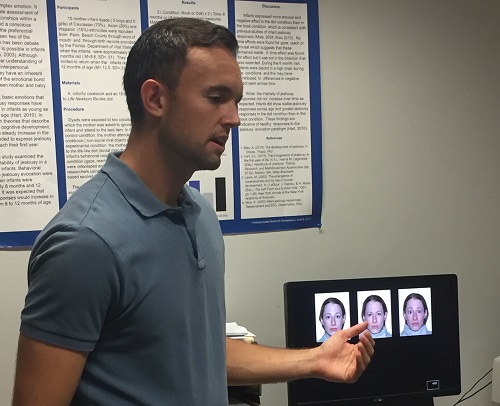Children with Autism Are ‘In-tune’ With Mom’s Feelings

Children with high-functioning autism spectrum disorder (ASD) have adept and competent emotional processing skills when viewing their mother’s faces. They are just as “in-tune” with their mother’s feelings and emotions as children without ASD. This finding may indicate greater potential for children with ASD to learn and socialize with people they know rather than with strangers.
The ability to read facial expressions is key to interpreting important social cues during a conversation. For children with autism spectrum disorder (ASD) who commonly show impairments in social interactions, recognizing emotions in others is especially challenging. They also are hindered by a lack of interest in initiating conversation and atypical eye contact.
Although prior studies have assessed the ability to recognize facial emotion in both children and adults with ASD, results have been surprisingly inconsistent. Furthermore, studies in children with ASD have typically only tested using unfamiliar images, with two-types of expressions, “neutral” and “emotional,” and with wide age-ranges.
To address these limitations, researchers from ’s conducted a study in children with and without ASD, ages 4 to 8 years old, using five distinct facial emotions; happy, sad, anger, fear, and neutral, which served as a control. They used facial emotion recognition tasks that featured both familiar and unfamiliar faces. They wanted to test how familiarity influences performance in these two groups of children using a constant familiar stimulus – their mothers.
The researchers also explored how high-functioning children with ASD differed from typically developing children in their ability to recognize positive and negative facial expressions. Evidence has shown that children with ASD have a harder time recognizing negative facial expressions like sadness and anger compared to positive expressions like happiness and excitement.
Results of the study, published in the journal , provide evidence that children without ASD are more proficient in recognizing unfamiliar facial emotion expressions than children with ASD, particularly for negative emotions like fear and sadness.
Interestingly, the researchers discovered that children with high-functioning ASD have adept and competent emotional processing skills when viewing their mother’s faces. They are just as “in-tune” with their mother’s feelings and emotions as children without ASD. The two groups of children did not differ in recognizing expressions from familiar faces.
‚ÄúThe result that the two groups of children did not differ in their ability to recognize familiar expressions is very insightful. Previous neurological and eye-tracking studies have hinted at this possibility, but it has rarely been demonstrated at the conscious level on a self-report test,‚Äù said Nathaniel A. Shanok, lead author and a Ph.D. student working with co-author , Ph.D., an associate psychology professor and director of the in ∞ƒ√≈¡˘∫œ≤ ¿˙ ∑º«¬º‚Äôs College of Science, and a member of ∞ƒ√≈¡˘∫œ≤ ¿˙ ∑º«¬º‚Äôs and . ‚ÄúFuture large-scale studies should investigate if this effect also is pertinent to expressions from additional familiar individuals like fathers, siblings and classmates.‚Äù

Children with ASD are less skilled at processing emotional information, especially sad faces, when they view the faces of strangers. Findings from this study show that children with ASD are perceptive to their mother‚Äôs emotions, which may indicate greater potential to learn and socialize with people they know rather than with strangers. ¬Ý
“It’s unclear whether the ability of children with autism spectrum disorder to gauge emotional information from strangers’ faces is due to genuine deficits in their processing ability, the indifferent nature of negative emotions, or due to a general pattern of disinterest in negative emotion displays or unfamiliar people,” said Aaron Jones.
Shanok, Aaron Jones and Nikola N. Lucas, Ph.D., co-author at in San Diego, note that for children with ASD, further difficulties in recognizing negative or complex facial emotional expressions may be due in part to variations in eye contact and eye tracking behavior. Other studies have shown that these children focus less on the eyes and more on other facial areas that are less informative of an individual‚Äôs emotional state. This finding explains their difficulty with recognizing sad and other expressions as well as rarely struggling with recognizing happy expressions, as too was the case for the ∞ƒ√≈¡˘∫œ≤ ¿˙ ∑º«¬º study.
This study highlights the importance of understanding facial emotion recognition skills in children with ASD and potentially enhancing facial emotion recognition tasks to include expressions from both familiar and unfamiliar individuals. The researchers say administering this type of task in children who vary in socio-emotional processing skills may help developmental scientists and clinicians to understand the types of social situations that are more challenging for this group.
Portions of this study are being presented at the upcoming Society for Research in Child Development conference in Baltimore and will examine the links between brain activation patterns and emotion processing in children on the autism spectrum. In addition, this research continues to be conducted as the ∞ƒ√≈¡˘∫œ≤ ¿˙ ∑º«¬º WAVES laboratory team is currently collecting data using a computerized program that gradually moves from one expression to the next (a morphing program) in hopes to understand real-time emotional processing abilities in children with autism. For more information or to participate, call 561-799-8632.
According to the U.S. Centers for Disease Control and Prevention, about 1 in 59 children has been identified with ASD, which occurs in all racial, ethnic, and socioeconomic groups. ASD is about four times more common among boys than among girls. ASD is characterized by ongoing social problems that include difficulty communicating and interacting with others, and repetitive behaviors as well as limited interests or activities. Symptoms are typically recognized in the first two years of life and affect the individual’s ability to function socially, at school or work, or other areas of life.
-∞ƒ√≈¡˘∫œ≤ ¿˙ ∑º«¬º-
Tags: science | students | research | faculty and staff | jupiter